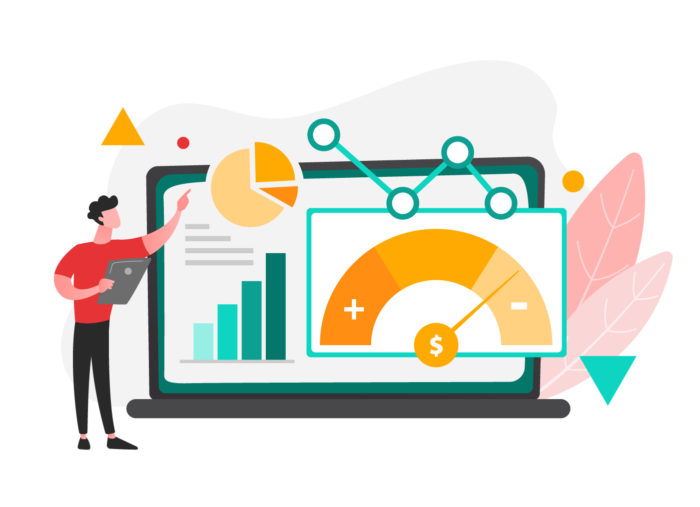Successful eCommerce businesses have goals, strategies, and plans to increase conversions — that is, to convert visitors into paying customers and keep them returning for the long term.
However, your primary business goal should be to give your customers the best experience possible.
After all, customers are the lifeblood of a business; without your customers, you don’t have a business.
When you make data-driven, customer-centric improvements to your site, you should see improved results with customers and your goals.
In fact, according to Forbes, there is more than an 80% increase in revenue for businesses that focus on improving the customer experience.
The data is clear: a solid digital strategy—that focuses on the customer experience first—is the key to eCommerce business success.
With that in mind, we’ll discuss the following:
Table of contents
Ready? Let’s jump in.

What is a Digital Strategy?
Digital Strategy vs. Digital Marketing Strategy
While digital strategy and digital marketing strategy are used interchangeably, they are not the same.
A digital strategy is a plan to diagnose or resolve specific online challenges with concrete steps, called tactics, to achieve business goals. Those online challenges could be with the eCommerce website, IT infrastructure, database marketing, or any other technology that can aid in maintaining and growing a business.
On the other hand, a digital marketing strategy is a plan for generating brand awareness and recognition online to help achieve sales and marketing goals. This is key to increase conversions. Digital marketing strategies include organic and paid search, social media, and other digital marketing campaigns, like email marketing.
What Are the Steps of a Digital Strategy?
- Define the opportunity
Understand and clearly articulate the digital challenges, opportunities, and obstacles. - Set goals
Create digital strategy goals that align with your business goals. - Understand your customers
Create buyer personas to help you understand your customers’ wants and needs. - Define optimization tasks
Assess opportunities and gaps; create optimization tasks to support the end goals. - Analyze and track performance results
Baseline current situation and incrementally track performance; optimize accordingly.
What is Customer Experience Optimization?
Customer experience optimization is the practice of creating and maximizing the customer journey touchpoints—each point where customers interact with your product and brand—to benefit the customer to achieve specific business goals.

What is Conversion or Conversion Rate Optimization (CRO)?
Optimizing the customer experience increases the rate at which prospects become customers, subscribers, or leads.
How?
Make incremental data-driven changes to your customer experience—whether on the website, app, or store—to achieve the desired results.
One of the most impactful parts of CRO is the practice of continually analyzing, testing, and optimizing the customer experience to improve results and achieve business goals.
By keeping an eye on performance, you can track how close—or not—you are to hitting your goals.
7 Ways to Increase eCommerce Conversions
1. Know and Understand Your Customers’ Buying Behavior and Customer Journey
To improve your customers’ experiences significantly, know and understand why and how they make purchases on your site. Knowing your customers requires having an intimate understanding of their wants and needs, along with the data to support associated decisions.
But how do you get to know your customers? Ask them. Here’s how:
- Polls
- Surveys (Survey Monkey, Facebook, other Social Media)
- Pre- and post-purchase feedback forms
- One-on-one interviews
- Focus groups
- Quizzes
Getting customers’ opinions on your products, services, or website can be as easy as asking them. It might take a little effort to capture customers’ feedback, but what you learn will be invaluable and more than worth the effort.
2. Create an Optimization Strategy
Based on customer feedback and other information, create an optimization strategy. Be realistic with time frames, resources, and tasks. Keep your business goals top of mind. After all, your digital strategy supports your overall business goals; therefore, everything you do should support those goals.
Tip: Use a spreadsheet or project management software like ClickUp or Wrike to track Digital strategy tasks.
3. Identify Sales Funnel Issues
Use Google Analytics Behavior Flow or a similar analytics platform to identify underperforming pages and drop-off issues. Behavior Flow lets you see how customers move through your site and where problems are so that you can increase conversion rate.
Look for pages with the following:
- High bounce rates.
Base performance on the page type. For instance, a blog page or article may have higher bounce rates since the goal is for the customer to read the article. - Drop-off areas
Which sections of your site are visitors dropping off? For example, having too many steps in a funnel can cause friction and increase drop-off rates. Figure out why and fix the associated issues. - Low conversion rates
If your conversions are trending downward, especially if the low conversions are associated with specific pages, take a closer look to identify the issue. Is the offer compelling? Do the request and landing page match? Is there off-putting language or messaging? Technical issues? Look for anything that could be preventing customers from achieving their goals on your site. - Increased paid media costs
High-paid search customer acquisition costs can indicate the low quality of your ads and associated landing pages. For instance, a disconnect from the ad to the landing page could cause traffic to immediately bounce from your site—resulting in higher paid media costs. - Decreased traffic
Your paid and earned media should be driving more—not less—traffic to your site. While there are always fluctuations in traffic due to seasonality or other external factors, a sharp and consistent dip in traffic indicates an issue that you need to address ASAP.
4. Reduce Cart Abandonment by Optimizing the Checkout Experience
Customers abandon carts for many reasons. The main reason, however, is a poor-checkout experience. According to the Baymard Institute, customers abandon carts almost 70% of the time. But why? Friction. Anything that prevents a customer from immediately completing the checkout process.
Here is a list of potential reasons for a high cart abandonment rate:
- Window and comparison shopping
- Adding to cart to get the discounted price
- No guest checkout (mandatory account creation)
- Complicated checkout process
- No coupons, discounts, or promo codes
- No free shipping, high shipping costs, or complicated shipping process
- Limited payment options
- Site speed and performance issues
- Product or quantity restrictions
- Payment processing or security concerns
- Unclear return or refund policies
5. Make the buying process easy to increase conversions
The easier you make it for customers to buy from you, the more likely they will convert. Make shopping easy by having a user-friendly website with straightforward navigation, an intuitive checkout process, and fast loading times. You should also offer multiple payment options and ensure your site is mobile-optimized so customers can purchase from you no matter where they are.
6. Provide quality product photos and descriptions
Customers who can’t physically see or touch your products must provide high-quality photos and detailed descriptions to know exactly what they’re buying. Be sure to highlight unique features or selling points and include size charts or other information to help customers make the best purchase decision.
7. Offer free shipping or other incentives
Customers love free shipping, so offering it on your site can be a great way to increase sales. If you can’t afford to offer free shipping, consider giving customers a discount or other incentive for spending a certain amount, such as free shipping on orders over $100.
6 Metrics to Help You Increase Conversions

1. Revenue
This is perhaps the most critical metric for any eCommerce business. Without revenue, there is no business. Monitoring revenue regularly can help you spot trends and adjust your business model accordingly.
2. Average Order Value (AOV)
Another key metric to watch is your average order value. This metric measures customers’ average amount of money on each order. Increasing this number can have a significant impact on your bottom line. AOV can give you insights into what products or services are selling well and where you might be able to increase prices.
3. Conversion Rate
Your conversion rate is the percentage of visitors to your site who take action, such as making a purchase or signing up for a newsletter. A high conversion rate is an indicator of a successful eCommerce business.
4. Customer Lifetime Value
This metric measures the average amount of money a customer spends with your business over their relationship with you. Increasing customer lifetime value is a crucial goal for many companies.
5. Cost of Customer Acquisition
This metric measures how much it costs to acquire a new customer. Keeping this number low is essential to a successful eCommerce business.
6. Shopping Cart Abandonment Rate
This metric measures the percentage of visitors to your site who add items to their shopping cart but don’t complete the purchase. Reducing shopping cart abandonment is a crucial goal for many eCommerce businesses.
Create a CX and CRO Reporting Plan For Increased Conversions
Are you struggling to make sense of all your customer experience (CX) and conversion rate optimization (CRO) data? If so, you’re not alone.
The good news is that there is a way to make data meaningful. By creating a CX and CRO reporting plan, you can ensure that all your data is captured and analyzed in a way that drives meaningful insights and action.
Here’s what you need to know to create a CX and CRO reporting plan:
1. Define Your Goals
The first step in any reporting plan is to define your goals. For instance, determine: what do you want to learn from your data?
Some common goals for CX and CRO reporting include understanding customer satisfaction, identifying improvement areas, and measuring changes’ impact on conversion rates.
2. Choose the Right Data Points
Once you know what you want to learn from your data, you must choose the right data points to track.
There are a few different ways to approach this. One is to look at the data points that are most important to your goals. Another is to look at the data points most commonly used in CX and CRO reporting.
Some common data points to track include customer satisfaction scores, conversion rates, and NPS scores.
3. Create a Data-Driven Culture
One of the best ways to ensure that your data is used effectively is to create a data-driven culture within your organization. This means that everyone in your company should use data to make decisions, not just those responsible for analyzing it.
To create a data-driven culture, start by ensuring that everyone in your company understands the importance of data. For instance, you can hold regular training sessions or workshops on data and its applications.
You should also ensure that your employees have access to the data they need to do their jobs. This gives them the tools to collect, analyze, and visualize data.
Finally, it would help if you created a feedback loop so that employees can share their insights with you. This way, you can continually improve your data-driven culture.
Need help with your digital strategy? Increase your conversions and lower costs with our eCommerce conversion rate optimization and customer experience expertise. We’ll create a rock-solid eCommerce digital strategy to help you achieve your business goals.
Contact us today for a free consultation.
Gentian, CSO and co-founder of Shero Commerce, guides the company and client digital strategies. He's an expert in technical SEO, Inbound Marketing, and eCommerce strategy.






